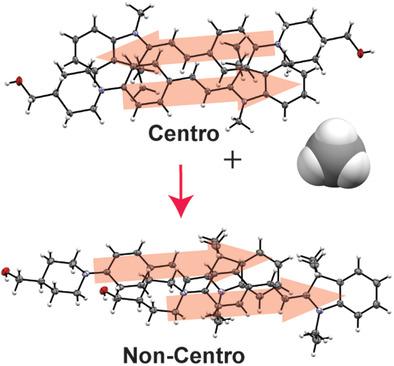当前位置:
X-MOL 学术
›
Adv. Funct. Mater.
›
论文详情
Our official English website, www.x-mol.net, welcomes your
feedback! (Note: you will need to create a separate account there.)
Designing Non‐Centrosymmetric Molecular Crystals: Optimal Packing May Be Just One Carbon Away
Advanced Functional Materials ( IF 18.5 ) Pub Date : 2019-10-28 , DOI: 10.1002/adfm.201904786 Gabriel A. Valdivia‐Berroeta 1 , Erika W. Jackson 1 , Karissa C. Kenney 1 , Adam X. Wayment 1 , Isaac C. Tangen 1 , Charles B. Bahr 1 , Stacey J. Smith 1 , David J. Michaelis 1 , Jeremy A. Johnson 1
Advanced Functional Materials ( IF 18.5 ) Pub Date : 2019-10-28 , DOI: 10.1002/adfm.201904786 Gabriel A. Valdivia‐Berroeta 1 , Erika W. Jackson 1 , Karissa C. Kenney 1 , Adam X. Wayment 1 , Isaac C. Tangen 1 , Charles B. Bahr 1 , Stacey J. Smith 1 , David J. Michaelis 1 , Jeremy A. Johnson 1
Affiliation

|
Molecular nonlinear optical (NLO) crystals feature important advantages compared to inorganic counterparts, such as low dielectric constants, ultrafast response times, and large electro‐optic coefficients. Conjugated push–pull chromophores connecting electron‐donating with accepting groups are often employed in the design of these crystals. However, associated large molecular dipole moments induce antiparallel or centrosymmetric conformations in the solid‐state, which leads to NLO inactivity. The cation–anion hydrogen bond interactions of a hydroxy‐piperidino electron donor group are combined with increased van der Waals volume effects induced by an ethyl modification of the electron‐accepting moiety. This produces non‐centrosymmetric packing in the organic salt EHPSI‐4NBS ((E)‐1‐ethyl‐2‐(4‐(4‐(hydroxymethyl)piperidin‐1‐yl)styryl)‐3,3‐dimethyl‐3H‐indol‐1‐ium 4‐nitrobenzenesulfonate). Converting a methyl group into ethyl changes the packing symmetry in the molecular crystal to switch on NLO activity. This behavior is attributed to the increased size of the ethyl group, which pushes apart the van der Waals contacts of the cation that lead to centrosymmetric packing in the methyl derivative. To test the NLO properties of EHPSI‐4NBS, THz generation experiments are performed at 1200 nm pump wavelength. Spectral amplitude similar to DAST ((E)‐4‐(4‐(dimethylamino)styryl)‐1‐methylpyridin‐1‐ium tosylate) crystal is observed with generation profile from 0 to 3.8 THz.
中文翻译:

设计非中心对称分子晶体:最佳堆积可能只是一个碳原子
与无机晶体相比,分子非线性光学(NLO)晶体具有重要的优势,例如低介电常数,超快响应时间和较大的电光系数。在这些晶体的设计中通常使用将给电子体与接受基团连接的共轭推挽生色团。但是,相关的大分子偶极矩会在固态中诱导反平行或中心对称构象,从而导致NLO失活。羟基哌啶子电子供体基团的阳离子-阴离子氢键相互作用与电子接受基团的乙基修饰引起的范德华体积效应增加。这会在有机盐EHPSI-4NBS((E)-1-乙基-2-(4-(4-(羟甲基)哌啶-1-基)苯乙烯基)-3,3-二甲基-3H-吲哚-1-基4-硝基苯磺酸盐)。将甲基转化为乙基会改变分子晶体中的堆积对称性,从而开启NLO活性。此行为归因于乙基的增加,这推开了阳离子的范德华接触,从而导致甲基衍生物中的中心对称堆积。为了测试EHPSI-4NBS的NLO特性,在1200 nm泵浦波长下进行了THz产生实验。观察到与DAST((E)-4-(4-(二甲基氨基)苯乙烯基)-1-甲基吡啶-1-甲苯磺酸盐)晶体相似的光谱幅度,其生成轮廓为0至3.8 THz。
更新日期:2020-01-17
中文翻译:

设计非中心对称分子晶体:最佳堆积可能只是一个碳原子
与无机晶体相比,分子非线性光学(NLO)晶体具有重要的优势,例如低介电常数,超快响应时间和较大的电光系数。在这些晶体的设计中通常使用将给电子体与接受基团连接的共轭推挽生色团。但是,相关的大分子偶极矩会在固态中诱导反平行或中心对称构象,从而导致NLO失活。羟基哌啶子电子供体基团的阳离子-阴离子氢键相互作用与电子接受基团的乙基修饰引起的范德华体积效应增加。这会在有机盐EHPSI-4NBS((E)-1-乙基-2-(4-(4-(羟甲基)哌啶-1-基)苯乙烯基)-3,3-二甲基-3H-吲哚-1-基4-硝基苯磺酸盐)。将甲基转化为乙基会改变分子晶体中的堆积对称性,从而开启NLO活性。此行为归因于乙基的增加,这推开了阳离子的范德华接触,从而导致甲基衍生物中的中心对称堆积。为了测试EHPSI-4NBS的NLO特性,在1200 nm泵浦波长下进行了THz产生实验。观察到与DAST((E)-4-(4-(二甲基氨基)苯乙烯基)-1-甲基吡啶-1-甲苯磺酸盐)晶体相似的光谱幅度,其生成轮廓为0至3.8 THz。









































 京公网安备 11010802027423号
京公网安备 11010802027423号